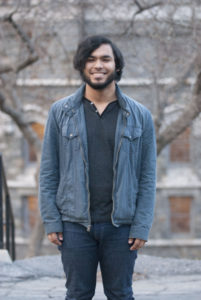
Wascar Ramirez
My friends who went to see “Black Panther” decided to wear outfits allowing them to embrace African pride. They complained that our peers asked why they were wearing such “extra” outfits.
It all comes down to one word: representation.
I saw “Black Panther” last week and it is easily one of the best movies I have ever seen, not only because of the great cinematography but for its genuine black representation and strong messages.
How often do we see films that depict black people as royal, powerful or genius?
Off the top of my head I can only think of Eddie Murphy’s character in “Coming to America,” which isn’t perfect by any means.
Though people of color are increasingly represented in Hollywood, we are typically stereotyped.
There aren’t many positive representations in films that show people of color as the amazing beings we are. This is a huge problem, considering not everyone in the world looks like who we see on TV.
For example, Omar Epps’ character in the TV show “House,” is arguably one of the best doctors on the show. House, the doctor for whom the show is named, only gives him a position on the team because he has a juvenile record for breaking into homes. House believes it’s better to break into patient’s homes and look for clues as opposed to speaking to them directly. Epps’ character’s accomplishments were completely overlooked for his “street smarts.”
“Black Panther” breaks the stereotypes perpetuated by almost every other media representation, such as blacks as ghetto or thugs.
In the movie, they are represented as powerful, authentic and humanly complex.
“Black Panther” is essentially an ode to black culture.
Africa is usually presented as backward, savage or uncivilized. “Black Panther” shows the fictional nation of Wakanda as a technologically advanced city with enormous skyscrapers, aircrafts and trains. It is portrayed as more advanced than any other city.
Princess Shuri, Black Panther’s sister, spearheads the technological advancements. She isn’t depicted as your typical princess spending the length of the plot searching for her prince. She is depicted as a technological genius.
She develops the suit her brother wears to absorb kinetic energy, giving him a tactical advantage. She is able to heal a gunshot wound to the spine overnight — something that takes real doctors months to treat.
Princess Shuri is incredibly confident in her inventions. After paying attention I noticed that she is the only character who teaches others how to use their technology. Shuri is the queen of her lab.
This kind of representation creates real impact.
I remember seeing this little girl on the bus after I watched “Brave” who was pretending to shoot arrows saying, “I didn’t know arrows were for girls. I want to learn.” There was a huge influx of girls joining archery after the movies “The Hunger Games” and “Brave” were released. They were inspired to tackle something new because they had a female role model challenging the stereotype that archery was only for boys.
Shuri could just as easily inspire more women to be involved in STEM fields, especially women of color who are vastly underrepresented in such fields.
A 2013 study by the National Science Foundation found black women earn only 10.7% of all bachelor’s degrees in science and engineering. They also represent less than 1% of all working scientists and engineers.
Shuri is the role model young black girls deserve.
In addition to black empowerment, “Black Panther” is also incredibly political and tackles topics that other superhero movies don’t bother approaching.
Black Panther’s antagonist, Erik Killmonger, is introduced by correcting the museum curator, saying that a weapon is actually from the technologically advanced African nation of Wakanda. But, he continues, the British army stole it, along with all the other artifacts on display, in the name of colonization.
Killmonger’s goal throughout the movie is to liberate all black people by arming them with vibranium, a precious metal from Wakanda. Interestingly enough, the character was born in Oakland, California, which also happens to be where the Black Panther Party was born.
Just as the Black Panther Party endured institutional racism by being targeted by the FBI, Killmonger can be seen as a symbol of centuries of pain endured by blacks all over the world.
At the end of the film my best friend turned to me and said, “Wascar, you have no idea how proud I feel to be black right now.” I echoed her pride, alongside so many others responded to the movie using #whatblackpanthermeanstome.
“Black Panther” is an inspiration of self-love for blacks. We are a powerful and beautiful people with diverse histories. I only hope that the momentum caused by this movie continues to grow so we can continue to flourish.
—
Wascar Ramirez, ’19, is an associate lifestyle editor for The Brown and White. He can be reached at [email protected].





Comment policy
Comments posted to The Brown and White website are reviewed by a moderator before being approved. Incendiary speech or harassing language, including comments targeted at individuals, may be deemed unacceptable and not published. Spam and other soliciting will also be declined.
The Brown and White also reserves the right to not publish entirely anonymous comments.
2 Comments
Typical black racism comments immortalizing a group of known anarchists.
You had reason to be proud before the movie came out. I haven’t seen it.
I’m wondering if “genuine black representation” is another name for a “positive” stereotype.
It’s good news to see more stories of blacks who have made an impact in world affairs. It’s also good to see blacks who are great in the fictional world.